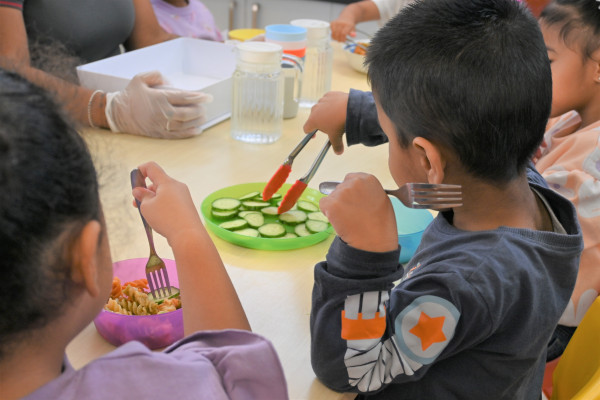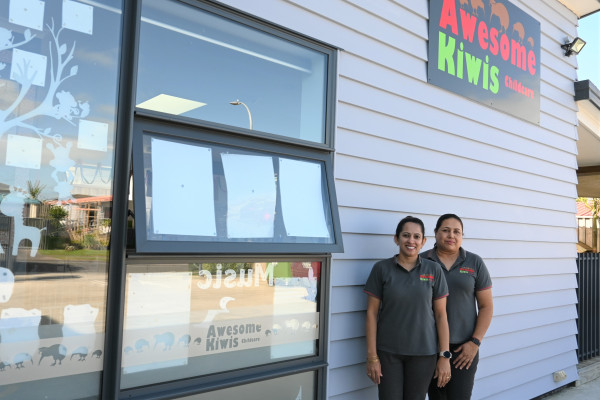AWESOME MEALTIMES AT AWESOME KIWIS
14.5.2024
At Awesome Kiwis Childcare in Manurewa, children are competent and capable leaders. Part of their secret is allowing children space to become food explorers during mealtimes.
“Our tamariki (children) serve their own food and decide how much they want to eat during mealtimes,” says co-owner, Ragni Lata. “We encourage them to follow their own hunger and fullness cues. If they are not hungry at lunchtime, the food is saved for later when they are feeling hungry.”
This approach creates a safe and inclusive space for children to increase their confidence in feeding themselves and to build positive relationships with food.
Getting whānau and tamariki on board
Awesome Kiwis opened in 2021, with co-owners Ragni Lata and Anita Singh leading a team of experienced staff who look after ten babies (under two years) and 30 children (over two years).
The centre prides on building positive relationships with food and creating opportunities for young children to get involved with learning about food at different stages.
“Babies are involved with mixing and pouring ingredients. Children can get more involved with the food preparing and cooking process,” says Ragni.
Whānau are regularly connected to the centre.
“We invite parents to bring along stories, recipes and their cooking. This isn’t only during language weeks – it’s ongoing.”
“We get good feedback and it gives parents an opportunity to get involved and share their cultures. Our teachers also get really involved with this as well. We don’t find it hard to organise when everyone is involved.”
Mealtimes are learning experiences
The magic happens during mealtimes, where all the children are sitting together, supervised by a staff member at each table. Lunch is cooked by Madhur, but everyone calls her ‘Nani’ (grandma in Indian culture).
Before the children start to dig in, everyone sings the centre karakia, with the help of Ministry of Education curriculum lead Angela Smith.
Whakapai Whakapai enei kai
He Oranga he oranga tinana, Amine
Tena koe Nani for the kai
On this particular day, staff at each table lift a lid to reveal lunch for the day.
“Cucumber!” exclaims one of the children. In the big serving bowl is cheesy chicken pasta and cucumber picked from one of the children’s whānau’s garden.
Children help themselves to the pasta with serving spoons and tongs and pass the big bowl around to share.
“It’s ok for them to get messy and explore food – it’s all part of the learning,” says Ragni.
Some take several scoops, others go for just one and ask for more later. This is normal as children listen to their bodies.
“For some new parents it can be a culture shock to let children decide when and how much they want to eat,” says Ragni. “To help whānau, we have a transition period so that the parents can come along for the first few days. A teacher will buddy up with whānau joining us to build the relationship.”
By the end of lunch, the tables are cleaned up by staff and children are ready to learn and play for the rest of the afternoon.
Awesome Kiwis recipe cards
Chickpea and potato curry [PDF]
Resource for centres: Four tips on building positive relationships with food (courtesy of Amanda Buhaets NZRD and Gabrielle Orr, NZRD)
For health advice call Healthline for free anytime on 0800 611 116
Resources
- All
- Alcohol
-
ARPHS translated resources
- Fact sheet - Typhoid and Paratyphoi…
- Fact sheet - VTEC/STEC (Samoan)
- Fact sheet - Dengue fever (Samoan)
- Fact sheet - Dengue fever (Tongan)
- Fact sheet - Dengue fever (Fijian)
- Fact sheet - Dengue fever (Cook Isl…
- Fact sheet - Hepatitis A (Samoan)
- Fact sheet - Hand washing and hygie…
- To view more click here
- Clinical pathways
- Dengue fever
- Early childhood education centres
- Hand hygiene
- Hazardous substances
-
Healthy Active Learning
- Weaving in culture for happy and en…
- Food for thought - learning from 5+…
- Planting seeds - growing St Mary's …
- Awesome mealtimes at Awesome Kiwis
- Embracing the thrills of risky play…
- Water play on a summer's day
- Flourish with nourishing celebratio…
- It’s not kindergarten without a gar…
- To view more click here
- Hepatitis A B C
- Influenza - The Flu
- Influenza-Like Illness
- Lead and lead poisioning
- Legionellosis
- Malaria
- Measles
- Meningococcal
- Monthly promotions
- Mumps
- Norovirus
- Organisational
- Rheumatic Fever
- Rotavirus
- Shigellosis
-
Submissions
- NPHS Northern Region Submission - A…
- Submission: Kaipara District Counci…
- Submission: Far North District Coun…
- Submission: Whangārei District Coun…
- Submission: Auckland Council Long-T…
- Submission: Auckland Integrated Tra…
- Submission: Annual Budget 2023-2024
- Submission: Smokefree Environments …
- To view more click here
- Tattooing
- Travelling
- Tuberculosis
- Typhoid and paratyphoid
- Vaccinator authorisation
- VTEC/STEC
- Water
- Whooping cough - Pertussis
- Yersiniosis

